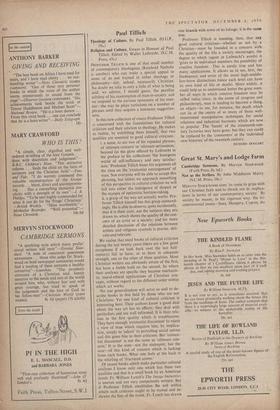Paul Tillich
Theology of Culture. By Paul Tillich. (O.U.P., 18s.) Religion and Culture. Essays in Honour of Paul Tillich. Edited by Walter Leibrecht. (S.C.M. Religion and Culture. Essays in Honour of Paul Tillich. Edited by Walter Leibrecht. (S.C.M.
• Press, 45s.) PROFESSOR T1LLICH is one of that small number of contemporary theologians (Reinhold Niebuhr
is another) who can make a special appeal to some of us not trained in either theology or philosophy—nor, indeed, necessarily Christian.
No doubt we take in only a little of what is being said; we admire, I should guess, the peculiar subtlety of his examination of man-in-society; and
we respond to the curious resonance of his man- ner—the way he plays variations on a number of phrases until they acquire a luminous suggestive- ness.
In this new collection of essays Professor Tillich is concerned with the foundations for cultural
criticism and their relation to theology. He makes us realise, by exhibiting them himself, that two qualities are essential to good cultural criticism : i. a sense, to use two of his repeated phrases, of 'ultimate concern' or 'ultimate seriousness,' beyond (in the gloss offered by Leibrecht in the preface to his collection) 'the bourgeois world of self-sulliciency and easy satisfac- tion.' Professor Tillich bases his argument all the time on the 'existential estrangement' of man. Not everyone will be able to accept this phrasing, but unless we approach something of this perspective in cultural criticism we will fall into either the indulgence of despair or the myopia of optimistic horizon-raking.
ii. a grasp of the way art actually works. Pro- fessor Tillich himself has this grasp outstand- ingly. He is able to observe, quite incidentally,
that it is their style, not the subjects they are drawn to. which shows, the quality of the con-
cern of an artist or a society; and his more detailed discussion of the relations between artistic and religious symbols is precise, deli- cate and relevant.
We realise that most books of cultural criticism during the last twenty years (there are a few good exceptions if we look back over the last half- century) fail to have, or to have in adequate strength, one or the other of these qualities. Most Christian writers are obviously aware of the first, but have a feeble hold on the second. So where their analyses are specific they become mechanis- tic moral-ethical applications of Christian con- cepts, without regard to the different order within which art works.
No one generalisation will serve so well to de- scribe books in this field by those who are not Christians. Yet one kind of cultural criticism is interesting here. Their authors know a good deal about the way art has its effects; they deal with particulars and are well informed. It is their rela- tion to the first quality which is troublesome. They have enough 'existential discontent' to reject a view of man which requires him, by implica-
tion, simply to 'adjust' to prevailing social norms and this gives bite to their criticism. But 'existen- tial discontent' is not the same as 'ultimate con- cern.' It is the note—not the statement, but the note—of this kind of concern which is lacking from such books. What one feels at the back is the whirling of 'fractured atoms.'
Of recent books which make particular cultural analyses I know only one which has these two
qualities and that is a small book by an American
Jesuit. Fr. William Lynch's The Image Industries is uneven and not very competently written. Bust
if Professor Tillich establishes the soil within which such criticism ought to be rooted and in- dicates the line of the trunk, Fr. Lynch has drawn
one branch with some of its foliage; it is the same tree.
Professor Tillich is insisting, then, that any good cultural criticism—whether or not by a Christian—must be founded in a concern with the quality of the life a society encourages, the degree to which (again in Leibrecht's words) it 'gives to its individual members the possibility of creative freedom. This is surely true and has many applications. It allows us to see, first, the inadequacy and error of the usual high-middle- low-brow distinctions (since each level can have its own kind of life or death). More widely, it could help us to understand better the great num- ber of ways in which creative freedom may be stilled today since, in the name of progress and philanthropy, man is tending to become a thing, an object—to see, for instance, the death which can lie at the centre of so many of those well- intentioned manipulative techniques for social relations and industrial harmony which are now so popular. The 'hands' of the nineteenth-cen- tury factories may have gone; but they can easily be replaced by the 'consumers' or the 'individual case histories' of the twentieth century.














































 Previous page
Previous page